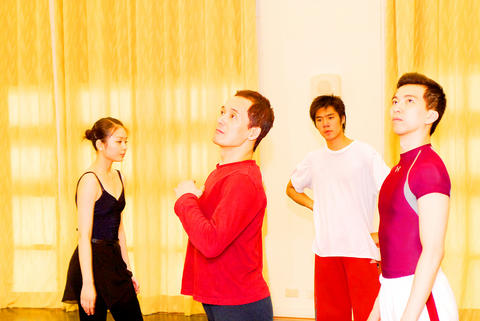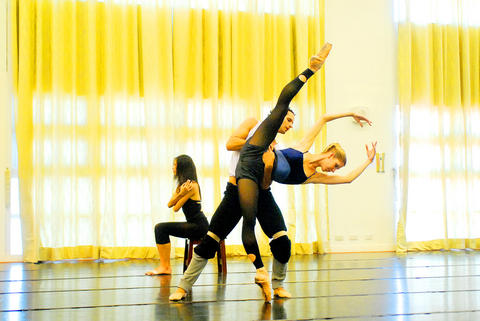Allen Yu (余能盛) feels a close connection with Peter Tchaikovsky. The Taiwanese ballet dancer and choreographer says he loves the 19th-century Russian composer's music, which he has frequently used in his own choreography, and he has read lots of biographies of him.
Last year he gave us a glimpse into the tortured composer's life by restaging his 1998 ballet, Tchaikovsky - None But the Lonely Heart for the Water Reflection Dance Ensemble. This year he is expanding on some of the themes raised in that work for When Ballet Meets Tchaikovsky at Taipei's Metropolitan Hall.
He's been hard at work for the past month, using his vacation time from the Opera House in Graz, Austria - where he is the deputy ballet director and choreographer - to put the finishing touches on three new pieces that make up Ballet Meets Tchaikovsky.

PHOTOS: COURTESY OF CHAMBER OF BALLET TAIPEI
Yu is also a man with a mission. He wants to raise the standards of ballet dancers in this country; standards that he says have sadly declined in recent years.
The situation "is even worse than 20 years ago before I went to Europe. Full-length ballets - no one does them here anymore so ballet dancers don't have the experience, the technique," he said. " We need to build up the dancers here, so I am doing my best to help build up the system."
For the dancers who auditioned for him during a brief visit he made in April, that has meant a lot of hard work. He selected 19 dancers and since he came back to Taipei at the beginning of last month, they have all been putting in long days. He said he told them to drop everything else, no outside classes, no other jobs.

"From 9 [am] to 10:30 [am] we have daily class. After that we have rehearsal until 5pm. The movements [in his ballets] are very fast, so you need strong feet and strong technique," he said. "This is how we dance in Europe. But the dancers here aren't used to this."
As he did last year, Yu has brought his soloists from Europe. Philippines-born Ardee Dionisio, who is a soloist with the Graz Opera House, was a standout in last year's production. Daniel Cimpean, a Romanian soloist with the Darmstadt Staatstheater in Germany, danced here several years ago in Yu's production of The Lady of the Camellias. Two new faces are from the National Ballet of Hungary: Bajari Levente is a principal dancer with that company and Pazar Krisztina is a soloist.
Tchaikovsky's music has long been a favorite of ballet masters and choreographers. Yu selected some pieces that will be familiar to ballet audiences, and one that is not. The first piece he used is the Concerto for violin in D, also known as Serenade, which George Balanchine used for his famous work for the New York City Ballet. The second piece is the Piano Concerto No 1 op.23, and the third is Symphony No 4 in F minor op.36, which Yu said gave him the biggest challenge - and headaches.
The three ballets that make up When Ballet Meet Tchiakovsky each tell a separate story, but Yu says that by the end, their connection is clear.
The first is a meditation on spiritual love, of living your life hemmed in by society, "like a bird in a cage," Yu said.
In the second piece, he said, the soloist is "like a bird looking for its way to freedom." In the third, the bird is finally free to fly away from its cage, he said - but not necessarily happier for it.
Yu says he loves Tchaikovsky's music for its combination of romance and sadness and because it provides him "with limitless imagination."
"It provokes me so much that I want to present my inner feelings on stage," he said.

This month the government ordered a one-year block of Xiaohongshu (小紅書) or Rednote, a Chinese social media platform with more than 3 million users in Taiwan. The government pointed to widespread fraud activity on the platform, along with cybersecurity failures. Officials said that they had reached out to the company and asked it to change. However, they received no response. The pro-China parties, the Chinese Nationalist Party (KMT) and Taiwan People’s Party (TPP), immediately swung into action, denouncing the ban as an attack on free speech. This “free speech” claim was then echoed by the People’s Republic of China (PRC),

Exceptions to the rule are sometimes revealing. For a brief few years, there was an emerging ideological split between the Democratic Progressive Party (DPP) and Chinese Nationalist Party (KMT) that appeared to be pushing the DPP in a direction that would be considered more liberal, and the KMT more conservative. In the previous column, “The KMT-DPP’s bureaucrat-led developmental state” (Dec. 11, page 12), we examined how Taiwan’s democratic system developed, and how both the two main parties largely accepted a similar consensus on how Taiwan should be run domestically and did not split along the left-right lines more familiar in

As I finally slid into the warm embrace of the hot, clifftop pool, it was a serene moment of reflection. The sound of the river reflected off the cave walls, the white of our camping lights reflected off the dark, shimmering surface of the water, and I reflected on how fortunate I was to be here. After all, the beautiful walk through narrow canyons that had brought us here had been inaccessible for five years — and will be again soon. The day had started at the Huisun Forest Area (惠蓀林場), at the end of Nantou County Route 80, north and east

Specialty sandwiches loaded with the contents of an entire charcuterie board, overflowing with sauces, creams and all manner of creative add-ons, is perhaps one of the biggest global food trends of this year. From London to New York, lines form down the block for mortadella, burrata, pistachio and more stuffed between slices of fresh sourdough, rye or focaccia. To try the trend in Taipei, Munchies Mafia is for sure the spot — could this be the best sandwich in town? Carlos from Spain and Sergio from Mexico opened this spot just seven months ago. The two met working in the